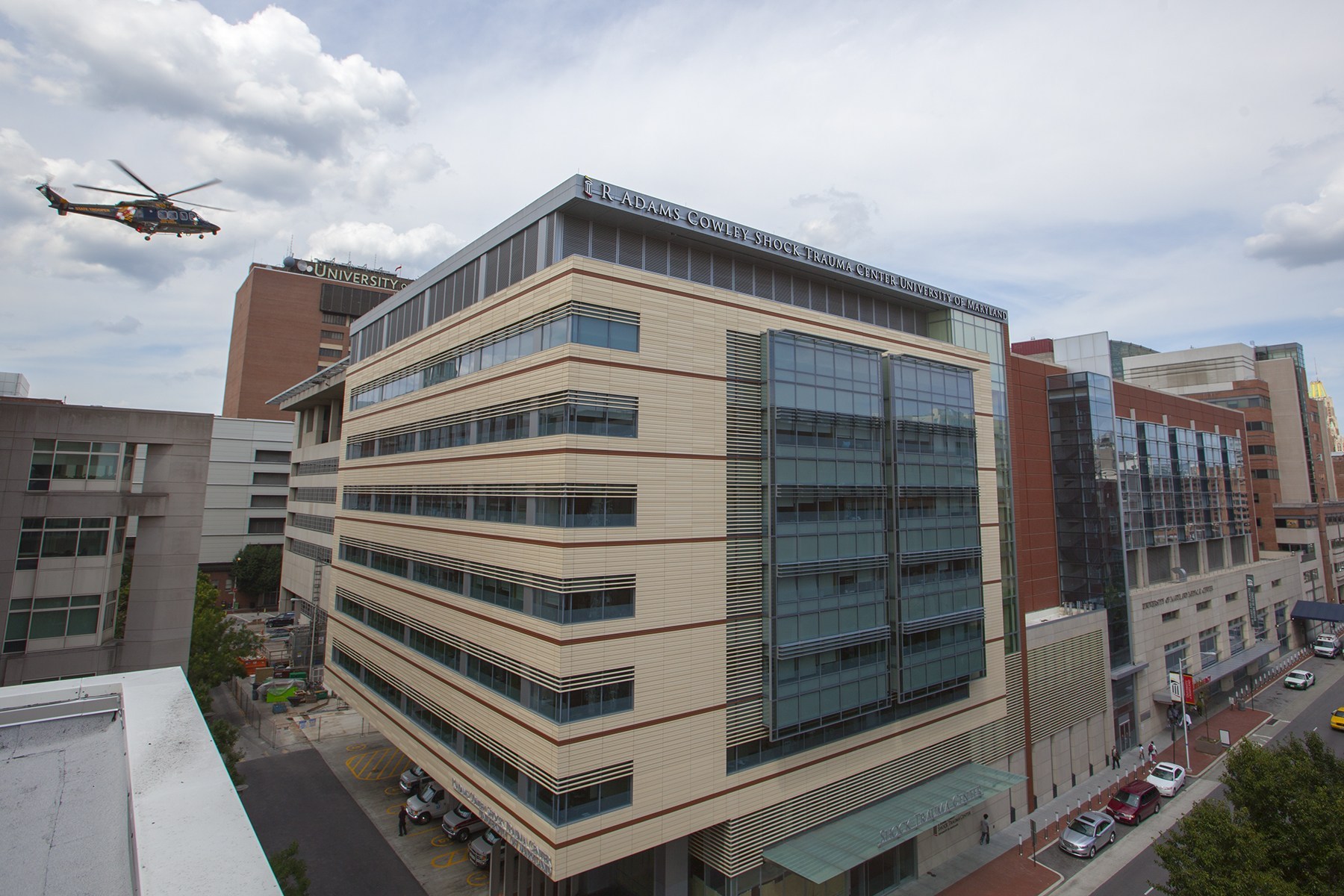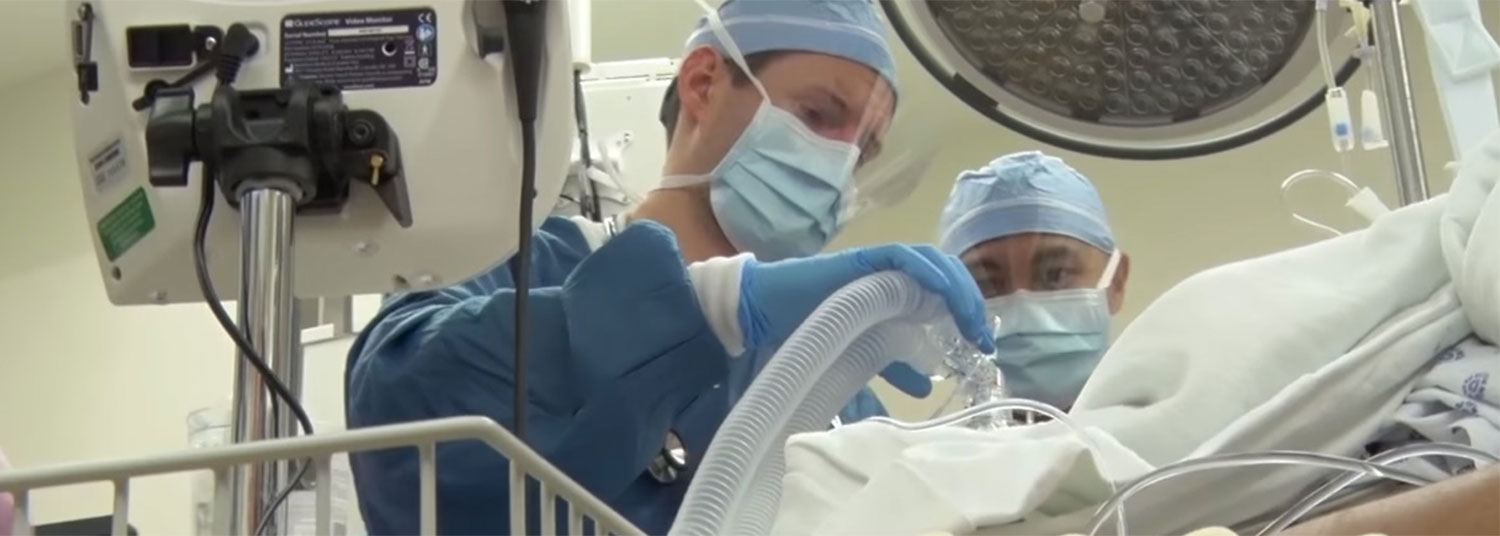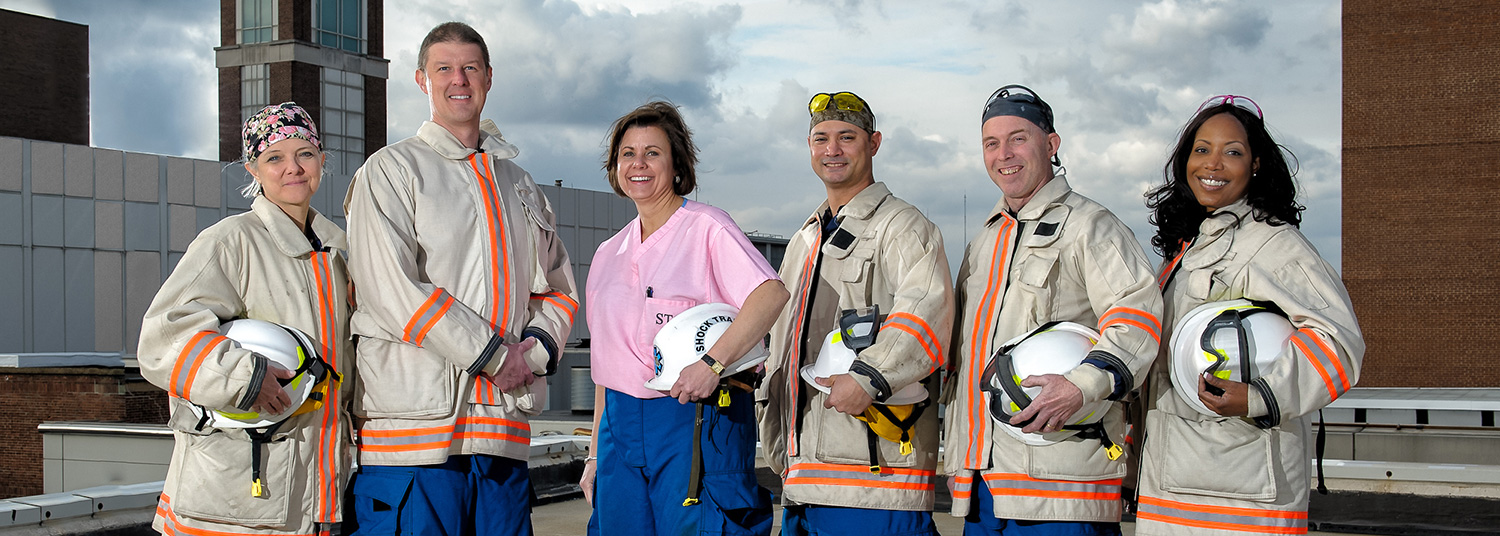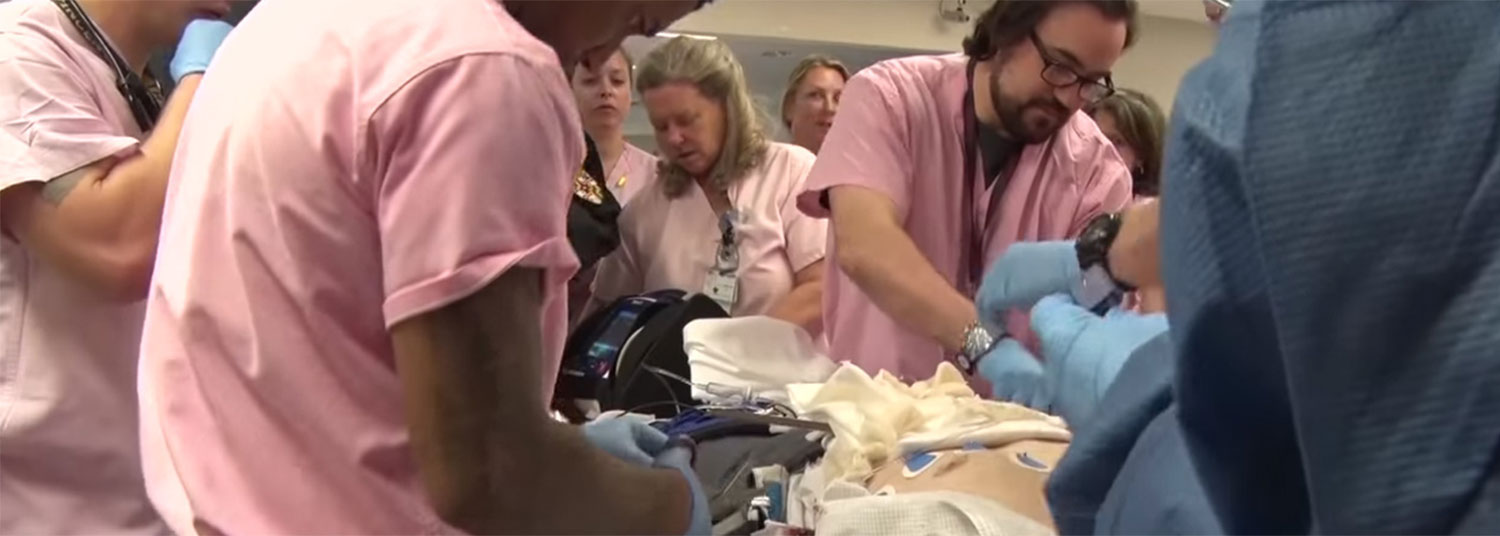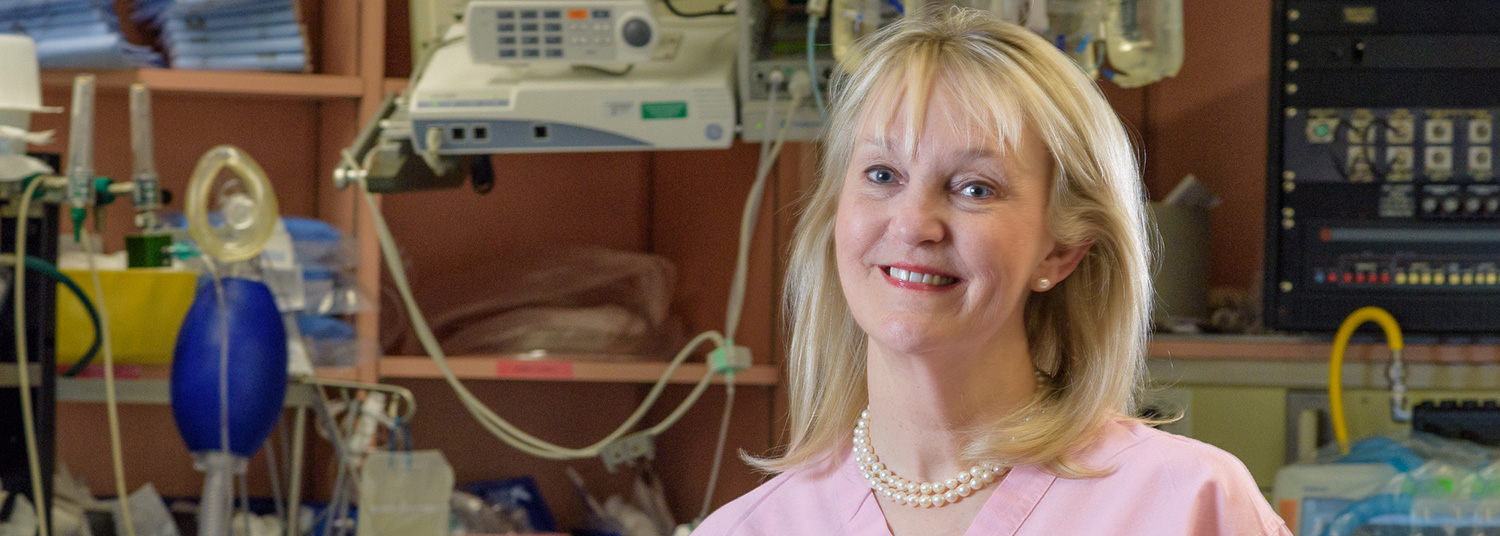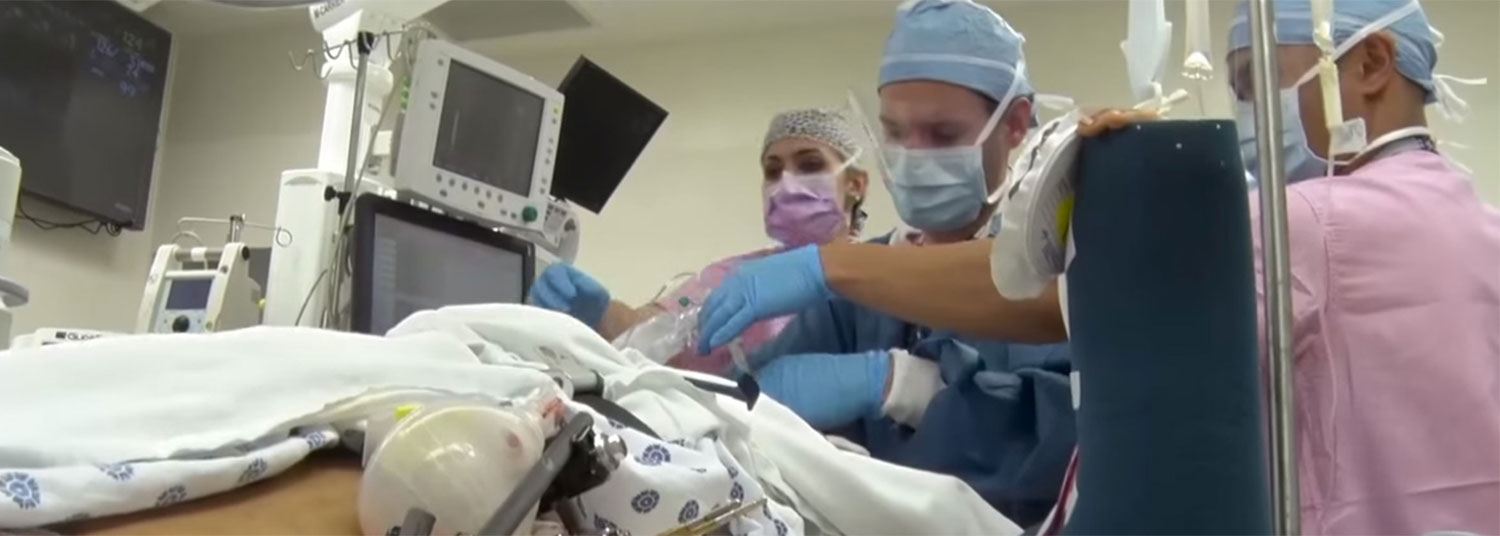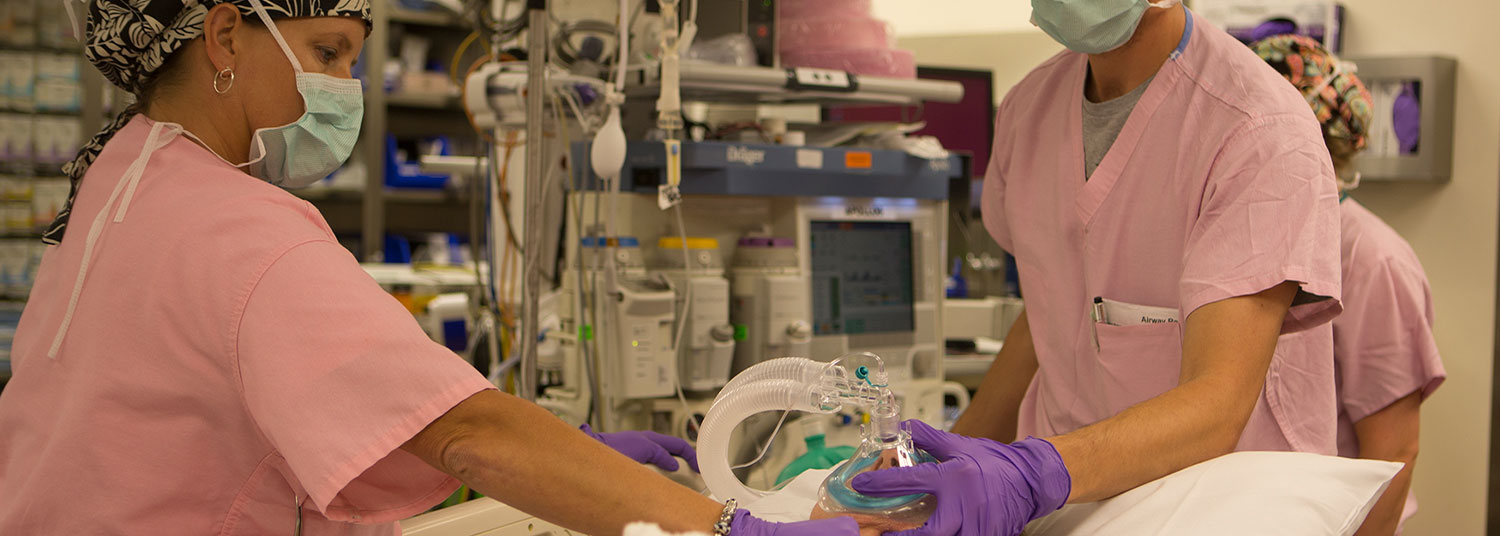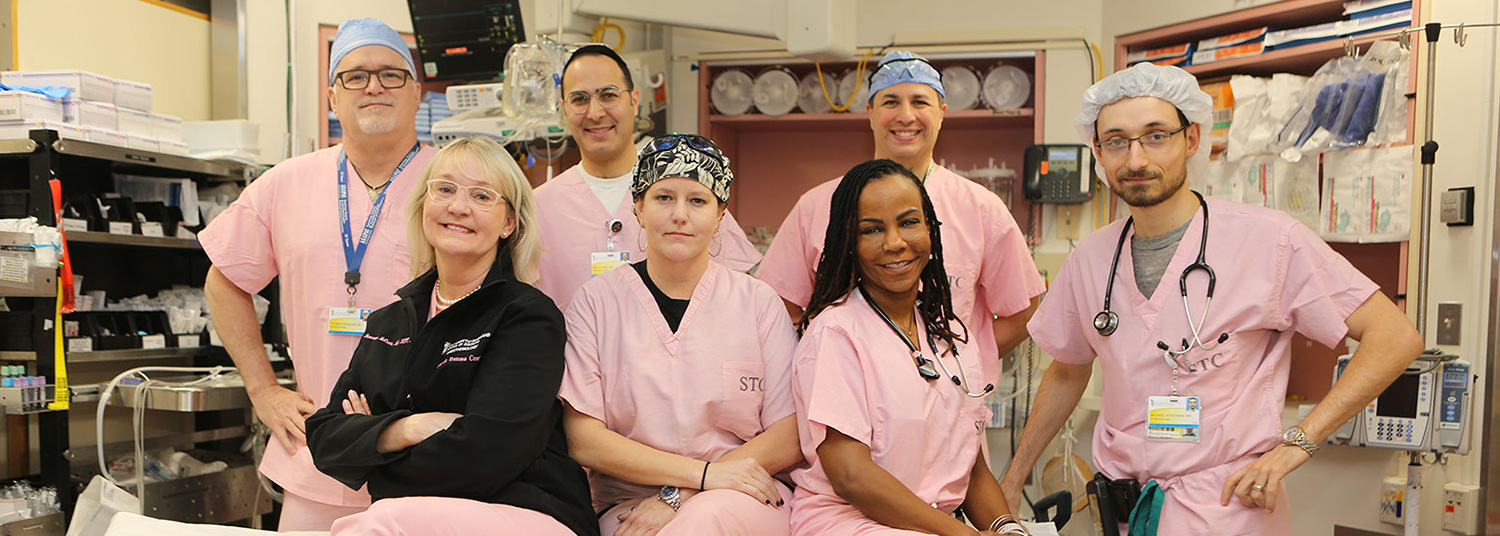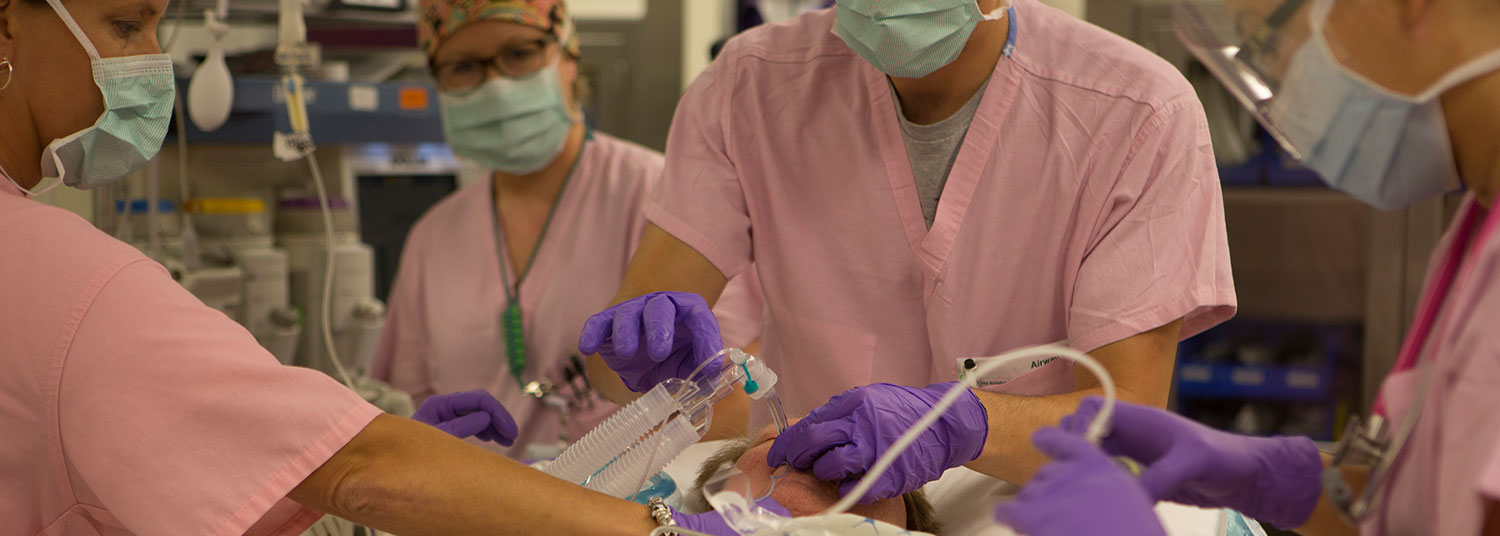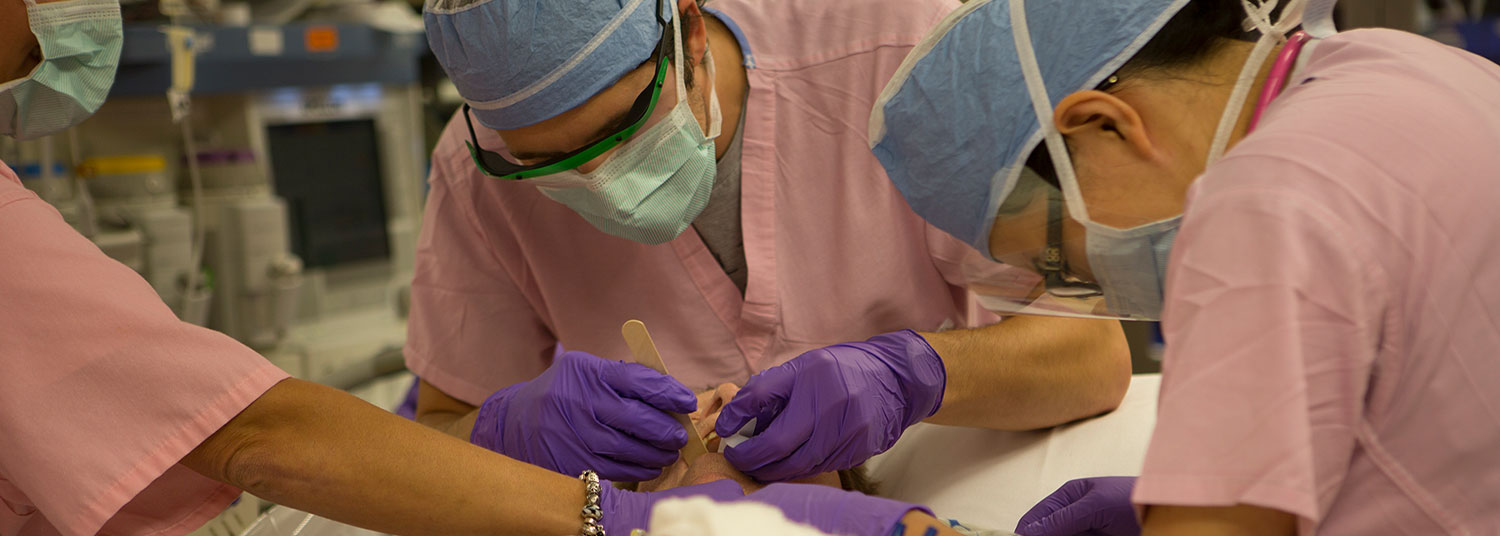Trauma Anesthesiology Fellowship Program
Message from the Program Director
 The mission of the R Adams Cowley Shock Trauma Division of Trauma Anesthesiology is to provide anesthesia expertise for the resuscitation and perioperative care of every critically injured patient at the trauma center. The Division of Trauma Anesthesiology is one of the only groups of anesthesiologists in the country with a practice focused specifically on traumatic injury, personally seeing each admission to the trauma bay on patient arrival. Our clinical practice incorporates acute pain management, regional anesthesia, intensive care medicine, echocardiography and long-term follow up care of patients after injury. Fellow rotations may also include pre-hospital ground and air retrieval, Multitrauma and Neurotrauma ICU coverage, and Trauma Radiology, Focused Assessment with Sonography in Trauma.
The mission of the R Adams Cowley Shock Trauma Division of Trauma Anesthesiology is to provide anesthesia expertise for the resuscitation and perioperative care of every critically injured patient at the trauma center. The Division of Trauma Anesthesiology is one of the only groups of anesthesiologists in the country with a practice focused specifically on traumatic injury, personally seeing each admission to the trauma bay on patient arrival. Our clinical practice incorporates acute pain management, regional anesthesia, intensive care medicine, echocardiography and long-term follow up care of patients after injury. Fellow rotations may also include pre-hospital ground and air retrieval, Multitrauma and Neurotrauma ICU coverage, and Trauma Radiology, Focused Assessment with Sonography in Trauma.
An anesthesiologist is present at every patient's admission to the Shock Trauma Center to assess and manage the airway, and to facilitate early pain control. Venous access, transfusion and acute resuscitation may also be initiated. An Attending Anesthesiologist is available in-house 24 hours a day for emergency airway management in the ICUs, for conscious sedation procedures, for bedside procedures on ECMO patients, and for comprehensive perioperative care in the TRU, OR, and PACU. All of the surgeons at Shock Trauma are specifically trained in trauma (e.g. surgery, orthopedics), as are the nurses and the technicians.
The Division of Trauma Anesthesiology includes 14 full-time attending anesthesiologists (5 with additional board certification in critical care, 2 cardiac anesthesiologists, the Director of Regional Anesthesia at the University of Maryland, 2 United States Air Force (USAF) anesthesiologists and 2 part-time anesthesiologists, along with 25 CRNAs, performing more than 6,000 anesthetics each year. We enjoy a collaborative practice with all specialties at the trauma center due to our singular focus: rescue of the patient from the brink of death and restoration to a meaningful, productive life.
We welcome your interest in our training program and look forward to meeting you.
Justin Richards, MD, Assistant Professor, Program Director View Profile
Learn More about the Trauma Anesthesiology Fellowship Program
Education
In the 1980's, Shock Trauma began the first Fellowship in Trauma Anesthesia in the U.S. Our fellows are U.S. civilian and U.K. military clinicians, and the Division also trains 25 to 30 anesthesia residents each year, rotating in one-month blocks from the University of Maryland, the armed services, and visiting residents from across the country. Forty eight residents in emergency medicine and fellows in pulmonary/critical care and trauma surgery/critical care also gain their airway training through us. In addition, we are responsible for the annual training of 50 Maryland State Police flight paramedics and for 50 student nurse anesthetists. Finally, representatives of the Division also train and supervise the nurses of the Acute Pain Management Service, providing advanced pain management modalities for more than 1500 patients each year.
Anesthesiologists from the Division teach University of Maryland medical students in a “hands-on” airway management course in the third year, and again as they rotate through the STC during their anesthesia training. The exposure that paramedics, nurses, medical students, residents, fellows and the military gain at Shock Trauma to severely traumatized airways and to emergency management of the airway ensures that each patient these providers treat in the future will undergo the best possible care.
The USAF and the University of Maryland have a long standing partnership to integrate active duty anesthesiologists and CRNAs into the Division of Trauma Anesthesiology. While stationed at the USAF's Center for the Sustainment of Trauma and Readiness Skills (C-STARS), Baltimore, the active duty anesthesiologists and CRNAs are embedded with the civilian faculty. Working side-by-side with the expert civilian Anesthesia staff, the military personnel gain the critical clinical experience and academic support while learning from the world's leaders in anesthesia and resuscitation. This partnership allows the USAF to train over 300 medical personnel from bases around the world, translating into vital airway, anesthesia and resuscitation management for our injured and ill wounded warriors.
Simulation Training
Simulation training is an integral part of our educational program. A monthly simulation course of high risk challenging scenarios, conducted in a 10,000 square foot state-of-the-art Simulation Center, is taught by the faculty to airway and anesthesia rotators. From the control room, faculty observe participants and discuss lessons during post-simulation debrief meetings. Fellows are involved initially as participants in the simulation course and are transitioned to teaching roles to become leaders in trauma medicine.
Research Training
The discovery and promulgation of new and better ways of caring for injured patients is a core tenant of the Shock Trauma Center. Research endeavors of the Division of Trauma Anesthesiology include studies of airway management techniques and protocols, anesthetic drug selection, advanced resuscitation techniques for patients in hemorrhagic shock, and non-surgical approaches to hemostasis. Ongoing IRB-approved studies that our faculty lead are investigating pre-hospital resuscitation and transport; trauma team dynamics; multiple-organ failure in damage control orthopedic patients; predictors of chronic pain in patients after orthopedic trauma; and long term physical, emotional and financial needs of patients after injury. Our anesthesiologists are critical to the management of patients with retrograde endovascular balloon occlusion of the aorta (REBOA) and those enrolled in the NIH-funded Emergency Preservation Resuscitation (EPR) trial. In the field of intensive care medicine, members of the Division have presented and published work on advanced ventilator management, continuous renal replacement therapies, transesophageal echocardiography, and extra-corporeal circulation. The Anesthesiologists and CRNAs of the Division are the acknowledged national experts on anesthesia for trauma care, are sought out for textbook chapters, review papers and research publications in the Anesthesia, Surgical, and Critical Care arenas, and serve as invited speakers at local, national, and international conferences on a regular basis.
Fellowship Alumni
Our alumni go on to take prominent positions as division directors, national and international leaders in trauma education, ASA committee members and chairpeople, Board of Directors members, and trauma anesthesiology consultants.
Recent Publications
Zhu TH, Hollister L, Opoku D, Galvagno SM Jr. Improved Survival for Rural Trauma Patients Transported by Helicopter to a Verified Trauma Center: A Propensity Score Analysis. Acad Emerg Med. 2018;25(1):44-53.
Gerstein NS, Sanders JC, McCunn M, Brierley JK, Gerstein WH, West SD, Tawil I, Kraai EP, Boyd NH, Bronshteyn YS, Torgeson EL, Schulman PM. The Gun Violence Epidemic: Time for Perioperative Physicians to Act. Journal of Cardiothoracic and Vascular Anesthesia. 2018;(3):1097-1100.
Galvagno SM Jr, Mabry RL, Maddry J, Kharod CU, Walrath BD, Powell E, Shackelford S. Measuring US Army medical evacuation: Metrics for performance improvement. J Trauma Acute Care Surg. 2018;84(1):150-156.
Mazzeffi M, Tanaka K, Galvagno S. Red Blood Cell Transfusion and Surgical Site Infection After Colon Resection Surgery: A Cohort Study. Anesth Analg. 2017;125(4):1316-1321.
Galvagno SM Jr, Fox EE, Appana SN, Baraniuk S, Bosarge PL, Bulger EM, Callcut RA, Cotton BA, Goodman M, Inaba K, O’Keeffe T, Schreiber MA, Wade CE, Scalea TM, Holcomb JB, Stein DM, on behalf of the PROPPR Study Group. Outcomes after concomitant traumatic brain injury and hemorrhagic shock: A secondary analysis from the Pragmatic, Randomized Optimal Platelets and Plasma Ratios trial. J Trauma Acute Care Surg. 2017;83(4):668-674.
Conti BM, Fouché-Weber LY, Richards JE, Grissom T. Images in Anesthesiology: Video Laryngoscopy for Intubation after Smoke Inhalation. Anesthesiology: The Journal of the American Society of Anesthesiologists. 2017;127(4):709-709.
Conti BM, Richards JE, Kundi R, Nascone J, Scalea TM, McCunn M. Resuscitative Endovascular Balloon Occlusion of the Aorta and the Anesthesiologist: A Case Report and Literature Review. A&A Practice. 2017;9(5):154-157.
Kaslow O, Kuza CM, McCunn M, Dagal A, Hagberg CA, McIsaac JH 3rd, Mangunta VR, Urman RD, Fox CA, Varon AJ. Trauma Anesthesiology as Part of the Core Anesthesiology Residency Program Training: Expert Opinion of the American Society of Anesthesiologists Committee on Trauma and Emergency Preparedness (ASA COTEP). Anesth Analg. 2017;125(3):1060-1065.
Grissom TE, Richards JE, Herr DL. Critical Care Management of the Potential Organ Donor. Int Anesthesiol Clin. 2017;55(2):18-41.
Conti B, Greco KM, McCunn M. The Acute Care Anesthesiologist as Resuscitationist. Int Anesthesiol Clin. 2017;55(3):109-116.
Research
Members of the Trauma Anesthesia faculty have been widely published. For example, published research areas have focused on resuscitation, evaluation of non-anesthesia airway trainees and traumatic brain injuries. Faculty are currently involved in a variety of projects such as assessing non-invasive monitors to assist pre-hospital providers with triage decisions or interdepartmental studies investigating oxygen concentration and outcomes in orthopedic patients. We are currently participating in a multicenter prospective trial using circulatory arrest and deep hypothermia to facilitate timely surgical repair in patients who have sustained life threatening penetrating trauma. Yvette Fouche, MD, is collaborating with Sarah Murthi, MD, Department of Surgery, on the opioid prescribing practices for trauma patients. The goal of this study is to reduce opioid dependency in trauma patients both acutely and post discharge.
Recent Publications
- Verdiner RE, Choukalas CG, Siddiqui S, Stahl D, Galvagno S, et al. COVID-Activated Emergency Scaling of Anesthesiology Responsibilities Intensive Care Unit. Anesth Analg. 2020;131(2):365-377. PMID:32398432.
- Galvagno, S M. Jr.; Sikorski, RA.; Floccare, D J.; Rock, P; Mazzeffi, M A.; DuBose, J J.; Scalea, T M.; Miller, C; Richards, J E.; O’Connor, JV.; Mackenzie, C F.; Hu, PPrehospital Point of Care Testing for the Early Detection of Shock and Prediction of Lifesaving Interventions, SHOCK: December 2020 - Volume 54 - Issue 6 - p 710-716 doi: 10.1097/SHK.0000000000001567.PMID: 32453248.
- Jones KM, DiChiacchio L, Deatrick KB, Dolly K, Rea J, Galvagno S, Herr D, O’Connor J, Scalea T, Menaker J. Cardiac Arrest Prior to Initiation of Veno-Venous Extracorporeal Membrane Oxygenation Is Not Associated with Increased In-Hospital Mortality. ASAIO J. 2020;66(6):e79-e81. PMID:32479713.
- Deatrick KB, Mazzeffi MA, Galvagno SM Jr, Boswell K, Kaczoroswki DJ, Rabinowitz RP, Madathil RJ, Cornachione CR, Herr DL, Scalea TM, Menaker J. Breathing Life Back Into the Kidney-Continuous Renal Replacement Therapy and Veno-Venous Extracorporeal Membrane Oxygenation. ASAIO J. 2021 Feb 1;67(2):208-212. doi: 10.1097/MAT.0000000000001210. PMID: 32657829.
- Sanford Z, Madathil RJ, Deatrick KB, Tabatabai A, Menaker J, Galvagno SM, Mazzeffi MA, Rabin J, Ghoreishi M, Rector R, Herr Dl, Kaczorowski DJ. Extracorporeal Membrane Oxygenation for COVID-19. Innovations. 2020;15(4):306-313. PMID:32692258.
- Kelley KM, Bittle G, Scalea TM, Kaczorowski D, Galvagno S, Menaker J, Lauerman M.. Cannulation for Venovenous Extracorporeal Membrane Oxygenation After Ligation of the Inferior Vena Cava in a Blunt Trauma Patient. Am Surg. 2020;86(11):1582-1583. PMID:32755386.
- Mazzeffi M, Bathula A, Tabatabai A, Menaker J, Kaczorowski D, Madathil R, Galvagno S, Pasriga C, Rector R, Tanaka K, Herr D. Von Willebrand Factor Concentrate Administration for Acquired Von Willebrand Syndrome- Related Bleeding During Adult Extracorporeal Membrane Oxygenation. J Cardiothorac Vasc Anesth. July 2020. PMID:32758410.
- Morris NA, Patel N, Galvagno SM Jr, et al. The effect of platelet transfusion on functional independence and mortality after antiplatelet therapy associated spontaneous intracerebral hemorrhage: A systematic review and meta-analysis. J Neurol Sci. 2020;417:117075. PMID:32763508.
- Esposito EC, Jones KM, Galvagno SM Jr, Kaczorowski DJ, Mazzeffi MA, DiChiacchio L, Deatrick KB, Madathil RJ, Herrold JA, Rabinowitz RP, Scalea TM, Menaker J. Incidence of healthcare-associated infections in patients with fever during the first 48 hours after decannulation from veno-venous extracorporeal membrane oxygenation. Perfusion. August 2020:267659120948427. PMID:32820708.
- Radowsky JS, Mazzeffi MA, Deatrick KB, Galvagno SM, et al. Intoxication and overdose should not preclude veno-venous extracorporeal membrane oxygenation. Perfusion. October 2020:267659120963938. PMID:33043807.
- Galvagno SM Jr, Mazzeffi MA, Deatrick KB, Menaker J. The Age Barrier for VV ECMO-Where Should It Be? ASAIO J. 2021;67(1):e56. PMID:33074861.
- Spiegel R, Teeter W, Sullivan S, Tuchong K, Mohammed N, Sutherland M, Leibner E, Rola P, Galvagno Jr SM, Murthi SB. The use of venous Doppler to predict adverse kidney events in a general ICU cohort. Crit Care. 2020;24(1):615. PMID:33076961.
- Chow JH, Khanna AK, Kethireddy S, …Carpenter R,…Tanaka K, Galvagno SM, Scalea TM, Mazzeffi MA.. Aspirin Use Is Associated With Decreased Mechanical Ventilation, Intensive Care Unit Admission, and In-Hospital Mortality in Hospitalized Patients With Coronavirus Disease 2019. Anesth Analg. 2021;132(4):930-941. PMID:33093359.
- Richards JE, Medvecz AJ, O'Hara NN, Guillamondegui OD, O'Toole RV, Obremskey WT, Galvagno SM, Scalea TM. Musculoskeletal Trauma in Critically Injured Patients: Factors Leading to Delayed Operative Fixation and Multiple Organ Failure. Anesth Analg. 2020 Dec;131(6):1781-1788. doi: 10.1213/ANE.0000000000005252. PMID: 33186164.
- Shriki J, Galvagno SM Jr. Sedation for Rapid Sequence Induction and Intubation of Neurologically Injured Patients. Emerg Med Clin North Am. 2021;39(1):203-216. PMID:33218658.
- Tran QK, Famuyiwa O, Haase DJ, …Galvagno S. Care Intensity During Transport to the Critical Care Resuscitation Unit: Transport Clinician’s Role. Air Med J. 2020;39(6):473-478. PMID:33228897.
- Kelley KM. Galvagno SM, Wallis M, Mazzeffi MA, Deatrick K, Betzold R, Scalea T, Menaker J. Tracheostomy in Patients on Venovenous Extracorporeal Membrane Oxygenation: Is it Safe?. Am. Surg. 2020 Dec 19;3134820979595. doi: 10.1177/0003134820979595. Online ahead of print. PMID: 33342297.
- Quintana MT, Mazzeffi M, Galvagno SM, et al. A Retrospective Study of Infection in Patients Requiring Extracorporeal Membrane Oxygenation Support. Ann Thorac Surg. December 2020. PMID:33359722.
- Tabatabai A, Galvagno SM Jr, O’Connor JV, Scalea TM, Deatrick KB. Extracorporeal Life Support (ECLS): A Review and Focus on Considerations for COVID-19. Shock. 2021;55(6):742-751. PMID:33393754.
- Tabatabai A, Ghneim MH, Kaczorowski DJ, Shah A, Dave S, Haase DJ, Vesselinov R, Deatrick KB, Rabin J, Rabinowitz RP, Galvagno S Jr, O'Connor JV, Menaker J, Herr DL, Gammie JS, Scalea TM, Madathil RJ. Mortality Risk Assessment in Covid-19 Veno-Venous Extracorporeal Membrane Oxygenation. Ann Thorac Surg. 2021 Jan 21:S0003-4975(21)00104-1. doi: 10.1016/j.athoracsur.2020.12.050. Epub ahead of print. PMID: 33485917.
- Richards JE, Mazzeffi MA, Massey MS, Rock P, Galvagno Jr SM, Scalea TM. The Bitter and the Sweet: Relationship of Lactate, Glucose and Mortality After Severe Blunt Trauma. Anesth Analg; 2020 Dec 30. doi: 1213/ANE.0000000000005335. Online ahead of print. PMID: 33475264.
- Yang S, Mackenzie CF, Rock P, Lin C, Floccare D, Scalea T, Stumpf F, Winans C, Galvagno S, Miller C, Stein D, Hu PF. Comparison of massive and emergency transfusion prediction scoring systems after trauma with a new Bleeding Risk Index score applied in-flight. J Trauma Acute Care Surg. 2021;90(2):268-273. PMID:33502145.
- Lankford AS, Chow JH, Jackson AM, Wallis M. Galvagno Jr SM, Malinow AM, Turan OM, Menaker JA, Crimmins SD, Rector R, Kaczorowski D, Griffith B, Kon Z, Herr D, Mazzeffi MA. Clinical Outcomes of Pregnant and Postpartum Extracorporeal Membrane Oxygenation Patients. Anesth Analg. 2021;132(3):777-787. PMID:33591093.
- Nasa P, Azoulay E, Khanna AK, … Galvagno, Jr. SM,et al. Expert consensus statements for the management of COVID-19-related acute respiratory failure using a Delphi method. Crit Care. 2021;25(1):106. PMID:33726819.
- Shah A, Dave S, Galvagno S, et al. A Dedicated Veno-Venous Extracorporeal Membrane Oxygenation Unit during a Respiratory Pandemic: Lessons Learned from COVID-19 Part II: Clinical Management. Membranes. 2021;11(5). PMID:33919390.
- Richards JE, Fedeles BT, Chow JH, Morrison JJ. Renner C, Trinh AT, Schlee CS, Koerner K, Grissom TE, Bertzold, RD, Scalea TM, Kozar RA. Is Tranexamic Acid Associated With Mortality or Multiple Organ Failure Following Severe Injury? Shock. 2021;55(1):55-60. PMID:33337787.
- Grissom TE, Samet RE. The Anesthesiologist's Role in Teaching Airway Management to Nonanesthesiologists: Who, Where, and How. Adv Anesth. 2020 Dec;38:131-156. doi: 10.1016/j.aan.2020.08.002. Epub 2020 Oct 5. PMID: 34106831
- Huang N, Pérez P, Kato T, Mikami Y, et. al. Collaborators: Kleiner DE, Sampaio DM, . . . Chancer Z, Mazzeffi MA, Richards JE, et.al.SARS-CoV-2 infection of the oral cavity and saliva. Nat Med. 2021 May;27(5):892-903. doi: 10.1038/s41591-021-01296-8. Epub 2021 Mar 25. PMID: 33767405; PMCID: PMC8240394.
- Richards JE, Jackson BP. Whole blood for trauma patients: Outcomes at higher doses. Transfusion. 2021 Jun;61(6):1661-164. Doi: 10.1111/trf.16446. PMID: 34142730.
- Chow J, Richards J, Galvagno SM Jr, Coleman P, Lankford A, Hendrix C, Dunitz J, Ibrahim I, Ghneim M, Tanaka KA, Scalea TM, Mazzeffi MA, Hu P. The Algorithm Examining the Risk of Massive Transfusion (Alert) Score Accurately Predicts Massive Transfusion at the Scene of Injury and on Arrival to the Trauma Bay. 2021 Jun 24; Publish Ahead of Print. doi: 10.1097/SHK.0000000000001772.
How to Apply
Application Resources:
- Department of Anesthesiology Fellowship Application
- Information for Prospective UMMC Residents and Fellows
- International Medical Graduates
Your file is complete when we receive:
- The completed University of Maryland Application for Fellowship in Anesthesiology. The application must have an original signature.
- Current curriculum vitae
- Your Personal Statement (name and credentials should appear on the personal statement)
- A copy of your medical school transcript
- Your USMLE I, II & III /COMLEX scores
- Your specialty specific In-Service, In-Training exam or Board Scores
- Three letters of reference; one of which should be from the chairman or program director of your training program
All documents (items 1-6) should be submitted and received in full.
All Letters of Recommendation should be sent directly from the respective writer, unless the LORs are in a sealed envelope with their signature across the back.
Applications and LORs can be sent by postal mail or courier to:
Justin Richards, MD, Trauma Fellowship Program Director
c/o Residency & Fellowship Program Coordinator
Department of Anesthesiology
University of Maryland Medical Center
22 South Greene Street, Suite S11C00
Baltimore, Maryland 21201
Phone: 410-328-2628
Fax: 410-328-0546
Electronic submissions should be should be sent to: anesresfellcoor@som.umaryland.edu

